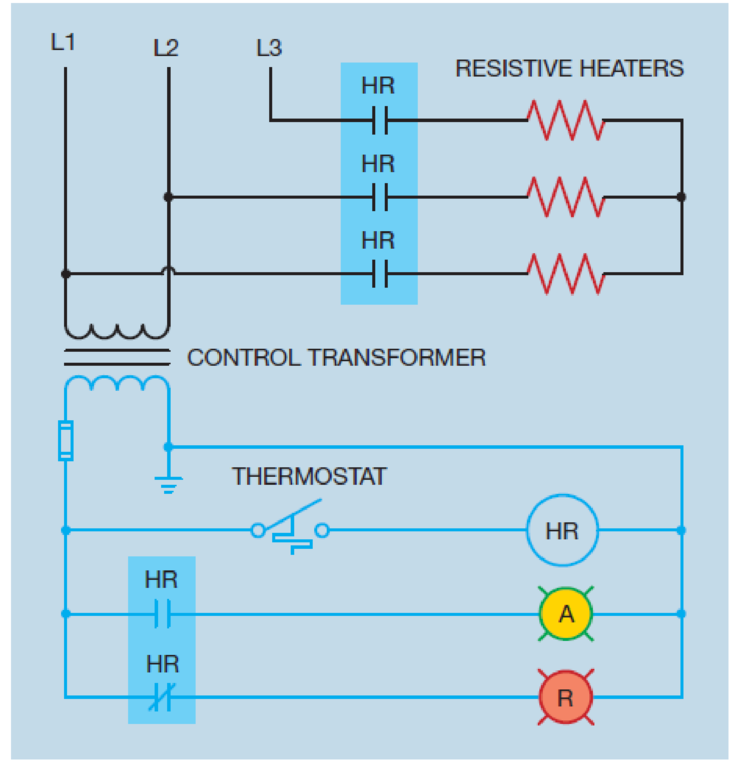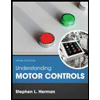
Understanding Motor Controls
4th Edition
ISBN: 9781337798686
Author: Stephen L. Herman
Publisher: Delmar Cengage Learning
expand_more
expand_more
format_list_bulleted
Textbook Question
Chapter 5, Problem 15RQ
Refer to the circuit shown in Figure 5-29. In this circuit, the HR contactor is equipped with five contacts. Three are load contacts and two are auxiliary contacts. From looking at the schematic diagram, how is it possible to identify which contacts are the load contacts and which are the auxiliary contacts?

Figure 5-29 The contactor contains both load and auxiliary contacts.
Expert Solution & Answer
Want to see the full answer?
Check out a sample textbook solution
Students have asked these similar questions
Question 2
a) Construct the signal flow graph (SFG) for the block diagram shown in Fig. Q2 (a) and
C($)
obtain the gain
using Mason's formula.
R(s)
04
-R()
01
0₂
0
Hi
h Sinded States Text Predictions On
Accessibility Unavailable
Fig. Q2 (a)
H₂
CA
How do you solve for the force acting on member BC?
A brake jaw, A is pressed against the drum, B. Calculate the brake arm, X(m₂).F= 250NBraking torque = 30Nmµ=0.35Around point A:Fm₂-Nm₁-µm₃=0N=Fm₂/m1+ µm₃MBrake =µ·D/2= µ·D/2MBrake =Fµm₂D/2(m₁- µm₃)(X)m₂=FµD/Mbrake·2(m1- µm₃)(X)m₂=250·0.35.0.3/30·2(0.250-0.35·0.06)=?I don’t get some likely value?
Chapter 5 Solutions
Understanding Motor Controls
Ch. 5 - Prob. 1RQCh. 5 - Prob. 2RQCh. 5 - Explain the difference between auxiliary contacts...Ch. 5 - Prob. 4RQCh. 5 - What is optoisolation and what is its main...Ch. 5 - What pin numbers are connected to the coil of an...Ch. 5 - An 11-pin control relay contains three sets of...Ch. 5 - What is the purpose of the shading coil?
Ch. 5 - Refer to the circuit shown in Figure 5-29. Is the...Ch. 5 - What is the difference between a motor starter and...
Knowledge Booster
Learn more about
Need a deep-dive on the concept behind this application? Look no further. Learn more about this topic, mechanical-engineering and related others by exploring similar questions and additional content below.Similar questions
- Q7 (12 Marks) For the system shown in Fig.3: 1- Draw the overall block diagram. 2- Determine the transfer function (Pc(s)/E(s)). Orifice→ Ps Actuating error signs) Flapper Pb+Pb. Nozzle. A X+X+ Ri A I R2 ㅍ think +y Pc+PCarrow_forwardFigures 4: show a pneumatic controller. The pneumatic relay has the characteristic that pc=K pb , where K>0. What kind of control action does this controller produce? a. Derive the mathematical model for the system b. Derive the transfer function Pc(s)/E(s) -Solve step by step Orifice F+Ph R₁ Actuating error signal Flapper Nozzle. x+x F+Pe thinkarrow_forwardThe equation of the turning moment diagram for the three crank engine and the equation of the moment required by a machine connected to this engine are given below: Engine Torque Machine Torque T=10000-500 sin (40) T=10000+2000 sin (20) N.m N.m where radians is the crank angle from inner dead center and the mean engine speed is 300 rpm. It is required to select a proper flywheel (find the moment of inertia of the flywheel in kgm2) and then calculate the power of the engine if the total percentage fluctuation of speed of the flywheel is ±1% of the mean speed. Calculate the angular acceleration of the flywheel when angle is 45°.arrow_forward
- Design a cotter joint to support a axial load of 100kN . Carbon steel material selected whichhas Tensile stress = 100MPa Compressive stress =150MPa; Shear stress =60MPaarrow_forwardDesign a cotter joint to support a axial load of 100kN . Carbon steel material selected whichhas Tensile stress = 100MPa Compressive stress =150MPa; Shear stress =60MPaarrow_forwardI need all the derivations from Bohr's postulates in handwritten formarrow_forward
- 12. Figure Q12 shows a prospective design for a conveyor roller system, for transferring crates, one at a time. The system is made up of two parallel rectangular steel beams, built-in at one end and simply supported at the other, with closely spaced rollers mounted in-between, for the crate to pass over. a) Using Macaulay notation, carry out an analysis of the problem and calculate the deflection of the mid-length point of the beams when the crate is centrally located, midway between A and B. State any important assumptions used in your analysis. [20 marks] b) Comment briefly whether this would be the maximum deflection of the beams when the crate is centrally located. 2 m 8 m A Direction of travel Figure Q12 (side view, only one beam visible) Useful information I for each separate beam = 12 ×10 m² E for both beams = 210 GPa Weight of one crate = 800 N [5 marks] Barrow_forward11. A ring (side view shown in Figure Q11) has a circular solid cross-section of 5 mm diameter. The ring itself has a radius of R = 100 mm and a very narrow gap at point A, that allows the two free ends to be pulled apart by forces P, increasing the size of the gap. ○ P A Figure Q11 P a) Show that the total strain energy of the ring due to the applied forces is: U = 3πP²R³ 2EI [12 marks] b) Find the maximum bending stress produced if forces of P = 8 N are applied. [6 marks] c) What minimum force P would cause the material in the ring to yield and at which locations could this yielding begin to occur? Useful information E for the ring material = 75 GPa Oyield for the ring material = 190 MPa [7 marks]arrow_forwardQ2(15 Marks): From Fig. 2, Determine (a) mass equivalent in term x2, (b) stiffness equivalent in term x2, and (c) the natural frequency for the system in term x2. Note: (1) J Cylinder = mcr? J link (2) 2 3 Pulley, mass moment of inertia J Rigid link 1 (mass m₁), rotates with pulley. about O Cylinder, mass m Adherence to the symbols as in the question 152 153 xx(1) Fig. (2) m k₁ nimmunizmu Rigid link 2 (mass m₂)arrow_forward
- Q3-B (7 Marks): A mass (m) is suspended from a spring of stiffness 4000 N/m and is subjected to a harmonic force having an amplitude of 100 N and a frequency of 5 Hz. The amplitude of the forced motion of the mass is observed to be 20 mm. Find the value of mass (m).arrow_forwardFig. (2) Q3-A (8 Marks): An automobile is modeled as a single-degree-of-freedom system vibrating in the vertical direction. It is driven along a road whose elevation varies sinusoidally. The distance from peak to trough is 0.2 m and the distance along the road between the peaks is 35 m. If the natural frequency of the automobile is 2 Hz and the damping ratio of the shock absorbers is 0.15, determine the amplitude of vibration of the automobile at a speed of 60 km/hour 6.18arrow_forward2. Q4(15 Marks): The motor-pump system shown in Fig. 4. is modeled as a rigid bar of mass m=50 kg and mass moment of inertia Jo=100 kg-m. The foundation of the system can be replaced by two springs of stiffness k=500 N/m and k₂-200 N/m and L=1 m. Determine the natural frequencies of the system. Motor, Fig. (4) 1 6(1) Pump C.G. x(1) x₁(1) Base (a) Foundation (b) C.G. m, Jo x2(1)arrow_forward
arrow_back_ios
SEE MORE QUESTIONS
arrow_forward_ios
Recommended textbooks for you
 Understanding Motor ControlsMechanical EngineeringISBN:9781337798686Author:Stephen L. HermanPublisher:Delmar Cengage Learning
Understanding Motor ControlsMechanical EngineeringISBN:9781337798686Author:Stephen L. HermanPublisher:Delmar Cengage Learning Electrical Transformers and Rotating MachinesMechanical EngineeringISBN:9781305494817Author:Stephen L. HermanPublisher:Cengage Learning
Electrical Transformers and Rotating MachinesMechanical EngineeringISBN:9781305494817Author:Stephen L. HermanPublisher:Cengage Learning Refrigeration and Air Conditioning Technology (Mi...Mechanical EngineeringISBN:9781305578296Author:John Tomczyk, Eugene Silberstein, Bill Whitman, Bill JohnsonPublisher:Cengage Learning
Refrigeration and Air Conditioning Technology (Mi...Mechanical EngineeringISBN:9781305578296Author:John Tomczyk, Eugene Silberstein, Bill Whitman, Bill JohnsonPublisher:Cengage Learning Automotive TechnologyMechanical EngineeringISBN:9781337794213Author:ERJAVEC, Jack.Publisher:Cengage,
Automotive TechnologyMechanical EngineeringISBN:9781337794213Author:ERJAVEC, Jack.Publisher:Cengage, Understanding Motor ControlsMechanical EngineeringISBN:9781305498129Author:Stephen L. HermanPublisher:Cengage Learning
Understanding Motor ControlsMechanical EngineeringISBN:9781305498129Author:Stephen L. HermanPublisher:Cengage Learning

Understanding Motor Controls
Mechanical Engineering
ISBN:9781337798686
Author:Stephen L. Herman
Publisher:Delmar Cengage Learning

Electrical Transformers and Rotating Machines
Mechanical Engineering
ISBN:9781305494817
Author:Stephen L. Herman
Publisher:Cengage Learning

Refrigeration and Air Conditioning Technology (Mi...
Mechanical Engineering
ISBN:9781305578296
Author:John Tomczyk, Eugene Silberstein, Bill Whitman, Bill Johnson
Publisher:Cengage Learning

Automotive Technology
Mechanical Engineering
ISBN:9781337794213
Author:ERJAVEC, Jack.
Publisher:Cengage,

Understanding Motor Controls
Mechanical Engineering
ISBN:9781305498129
Author:Stephen L. Herman
Publisher:Cengage Learning
Mod-01 Lec-16 Basics of Instrumentation; Author: nptelhrd;https://www.youtube.com/watch?v=qbKnW42ZM5c;License: Standard YouTube License, CC-BY